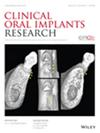两颗窄径种植体替代缺失上颌侧切牙的5年临床、影像学和软组织测量结果
IF 5.3
1区 医学
Q1 DENTISTRY, ORAL SURGERY & MEDICINE
引用次数: 0
摘要
目的比较两种不同窄径种植体(ndi)修复先天性上颌侧切牙(MLIs)患者的5年疗效。材料和方法100例患者在Ø2.9 mm(试验组)(n = 50)或Ø3.3 mm(对照组)(n = 50) (T1)上使用水泥保留的双层氧化锆单单元冠(T1)康复,随访1年、3年和5年(T2、T3、T4)。记录临床、放射学、患者报告的结果测量(PROMs)、生物/技术并发症和美学并发症。在获得口腔内光学扫描(IOS) (T4)后,识别出三种不同的软组织轮廓(线性,凹形和凸形)。结果T4组66例,每组33例;退出组n = 33;种植体成活率:99%;评估早期种植体丢失(n = 1)。T1和T4期间,Ø3.3和Ø2.9 mm种植体的冠骨水平(CBL)变化具有可比性(差异:0.24 mm;p比;0.05)。尽管记录的美观评分为阳性(即得分1-2),但在T4时,9.1%的Ø2.9 mm与18.2%的Ø3.3 mm种植体显示牙槽突缺陷(得分3)。软组织轮廓的频率为线性(21.2% vs. 40.6%)、凹形(72.7% vs. 37.5%)和凸形(6.1% vs. 21.9%) (Ø2.9 mm vs. Ø3.3 mm组;0.01])。并发症包括切牙、切牙边缘陶瓷碎裂(各3例)、基牙松动(1例)和颊瘘(3例)。两组在T1时显著改善的PROMs值保持稳定直至T4 (p >;0.05)。结论使用Ø2.9或Ø3.3 mm种植体具有相当的长期阳性结果。临床医生可以依靠这两种种植体来替代先天缺失的mli。本文章由计算机程序翻译,如有差异,请以英文原文为准。
Five Year Clinical, Radiographic and Soft Tissue Profilometric Outcomes at Two Narrow‐Diameter Implants to Replace Missing Maxillary Lateral Incisors
ObjectivesTo compare the 5‐year outcomes in patients with congenitally missing maxillary lateral incisors (MLIs) rehabilitated with two different narrow‐diameter implants (NDIs).Materials and MethodsOne‐hundred patients rehabilitated with a cement‐retained bi‐layered zirconia single‐unit crown on either a Ø2.9 mm (Test) (n = 50) or a Ø3.3 mm (Control) (n = 50) (T1) were assessed at 1‐, 3‐, and 5‐year follow‐up (T2, T3, T4). Clinical, radiographic, patient‐reported outcome measures (PROMs), biological/technical complications, and esthetic ones were recorded. After the acquisition of intraoral optical scans (IOS) (T4), three different soft tissue profilometric profiles (linear, concave, and convex) were identified.ResultsAt T4, 66 patients (n = 33 per group; drop‐outs n = 33; implant survival rate: 99%; early implant loss n = 1) were evaluated. Between T1 and T4, crestal bone level (CBL) changes at Ø3.3 and at Ø2.9 mm implants were comparable (difference: 0.24 mm; p > 0.05). Despite the positive recorded esthetic scores (i.e., Score 1–2), at T4, 9.1% of Ø2.9 mm versus 18.2% of Ø3.3 mm implants displayed alveolar process deficiency (Score 3). The frequency of soft tissue profilometric profiles was linear (21.2% vs. 40.6%), concave (72.7% vs. 37.5%) and convex (6.1% vs. 21.9%) (Ø2.9 mm vs. Ø3.3 mm group [p > 0.01]). Complications included decementation, ceramic chipping of the incisal edge (3× each), abutment loosening (1×) and a buccal fistula (3×). The statistically significant improved PROMs values at T1 remained stable up to T4 for both groups (p > 0.05).ConclusionThe use of Ø2.9 or Ø3.3 mm implants showed comparable positive long‐term results. Clinicians can rely on both implant types to replace congenitally missing MLIs.
求助全文
通过发布文献求助,成功后即可免费获取论文全文。
去求助
来源期刊

Clinical Oral Implants Research
医学-工程:生物医学
CiteScore
7.70
自引率
11.60%
发文量
149
审稿时长
3 months
期刊介绍:
Clinical Oral Implants Research conveys scientific progress in the field of implant dentistry and its related areas to clinicians, teachers and researchers concerned with the application of this information for the benefit of patients in need of oral implants. The journal addresses itself to clinicians, general practitioners, periodontists, oral and maxillofacial surgeons and prosthodontists, as well as to teachers, academicians and scholars involved in the education of professionals and in the scientific promotion of the field of implant dentistry.
 求助内容:
求助内容: 应助结果提醒方式:
应助结果提醒方式:


